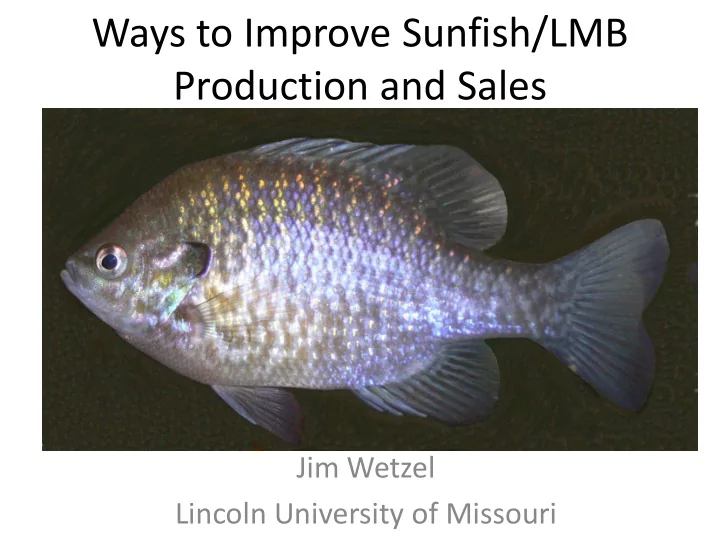

Ways to Improve Sunfish/LMB Production and Sales Jim Wetzel Lincoln University of Missouri
Bigmouth Bass http://wdfw.wa.gov/fishing/washington/Species/1738/
Largemouth Bass http://wdfw.wa.gov/fishing/washington/Species/1738/
Bluegill
Sunfish
Green Sunfish
Pumpkinseed
Longear Sunfish
Rockbass
Warmouth
Black Crappie http://www.crappie.com/crappie/main- crappie-fishing-forum/311019-fish- identification-2.html
Flier http://www.crappie.com/crappie/main- crappie-fishing-forum/311019-fish- identification-2.html
White Crappie
Black Crappie
Practice the Following • Know Actual Species in Hand and of Interest • Use Proper Name for Intended Market • Keep Species Separated – Avoid having to sort • Large numbers • Smaller fish
Sunfish Diversity • Genera • 39 Species – Lepomis spp. (Sunfishes) – 13 – Micropterus spp. (Black Basses) – 14 – Pomoxis spp. (Crappies) – 2 – Ambloplites spp. (Goggle-eyes) – 4 – Centrarchus sp. (Flier) – 1 – Archoplites sp. (Sacremento Perch) – 1 – Acantharchus sp. (Mud Sunfish) – 1 – Enneacanthus spp. (Little Sunfishes) – 3
Species of Economic Importance to the Midwest • Largemouth Bass • Bluegill • Hybrid Bluegill (Green Sunfish female x Bluegill male )* • Black Crappie • Redear • Pumpkinseed • White Crappie • Orange Spotted • Etc.
Markets • Stocking • Food • Bait • Forage • Display • Trophy* • Ornamentals
Size Important • Stocking (largest volume) – Fingerlings 1” to trophy size – $0.08 to $500 / fish – Least room for expansion • Food Fish (greatest potential for expansion) – ½ to 2 lbs – $4 to >$6 / lb – Lowest Profit Margin • Most investment / fish • Middle men • Producer has all the risk
Size Verses Price
Improving Margins • Control – Stocking Densities – Nutrition • Cost per unit gain – Feed cost / lb – Feed Conversion – Losses • Cannibalism • Size variation
Sunfishes Like to Breed • Control it! • All spawn as water warms • Most done by summer solstice – Bluegill is the most important exception • Some breed multiple times / season – Promotes size variation (can be very bad)
Quality Brood Fish • Nutrition! • Exposure to fall–winter–spring cycle (Bass/Crappie) • Large enough to breed – Age not that important • Uniform in size • In good condition – Bellies • Rounded – female • Firm – male – Color – Large opercular tabs – No wounds DO NOT BE AFRAID TO CULL
Know How to Sex Fish
The Breeding Sequence Imagine…….
Nest Construction • Tail Sweeping • Diameter approximately 1.5X length of male
Gamete Deposition
Brood Care • Embryos Sunfish / Crappie / Bass • Prolarvae • Larvae Bass • Fry Know What the Eat
Breeding in Ponds • Pond Preparation – Dry out • Controls pest • Stages plankton emergence – Prep dry bottom – Fill with water • Timing • Do not allow other species to come in!!!! – Fertilization • Organic • Apply based on appearance of water – Check at least weekly
Carrying Capacity Constraints • Forages for early life-stages – Strong plankton blooms • Zooplankton – Timing • Small larvae need to have abundant small / early blooms • Forages for fingerlings – Difficult to rear reliably in pond with stock – Bring in forages (minnows) • Expensive • Risky
Black Crappie • Ponds ready for brood fish as temperatures warm into upper 50’s F • Spawning starts in lower 60’s F • Nests typical deep in loose groups • Larvae first feeding about 2 weeks after adults introduced – Smaller early zooplankton typical of two weeks post filling
Largemouth Bass • Ponds ready for brood fish as temperatures warm into lower to mid 60’s F • Spawning starts in mid 60’s F • Nest spaced around perimeter of pond • Larvae first feeding about 3 weeks after adults introduced – Larger later zooplankton typical of 3 to for weeks post-filling • Extended parental care – Fry weaned when pushing 1”
Largemouth Bass (continued) • Target larger prey as they grow – Insects do not last long – Get along well so long as schooled up • Schools breaking up means forage failing – Leads to size variation cannibalism • Be ready to harvest quickly and grade • Stock immediately into another pond – Lower density – Fresh forage base • Transition to minnows ($$$) Or……
Feed Training • Confine at High Densities • High Exchange Rate – Remove waste frequently • Nutrient Dense Feeds (lots of animal protein) • THE FEEDING REGIMEN – Frequency – Do not startle – Show Them Love • Duration • Repeat
Bluegill • Ponds ready for brood fish as temperatures warm into upper 60’s F • Spawning starts in lower 70’s F – Continues into mid 80’s • Nests arranged in large tight groups – Unless stocking density low • Larvae first feeding about 2 weeks after adults introduced – Medium sized zooplankton typical of two weeks post filling
Bluegill (continued) • Most adaptable with respect to forages • Feed train easily as fry on up – Even in ponds • Extended breeding season makes for extremely variable size at harvest – Requires grading • Difficult to stop breeding in ponds – 3” is big enough
Growout Using Formulated Feeds • Size pellets to gape size of fish • Diets used for trout work well ($$$) – Least-cost formulation for Bluegill • Keep carbohydrates well • Feeding Regimen – Hand vs Automatic – Bluegill – multiple feedings / day – Crappie – multiple feedings / day – Largemouth Bass – multiple to single feedings / day
Goals • Larger in less time – More time means more risk • Higher condition factor – Tolerates handling better • Remember most markets based on live • Uniform size – Be setup to grade and rear sizes separately • They need to look good
QUESTIONS?
Recommend
More recommend